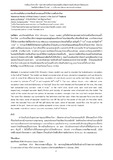| dc.contributor.author | อนงค์พรยศกุล, มณฑล | |
| dc.contributor.author | โศจิศุภร, ปราโมทย์ | |
| dc.contributor.author | อินแดง, ธัญญานุช | |
| dc.date.accessioned | 2020-04-07T08:50:40Z | |
| dc.date.available | 2020-04-07T08:50:40Z | |
| dc.date.issued | 2013-12 | |
| dc.identifier.citation | อนงค์พรยศกุล, ม., โศจิศุภร, ป., & อินแดง, ธ. (2013). แบบจำลองเชิงตัวเลขการเคลื่อนตัวของกระแสน้ำที่เกิดจากลมในอ่าวไทย. การสัมมนาวิชาการเรื่อง ผลการสำรวจทรัพยากรประมงและสิ่งแวดล้อมทางทะเลในบริเวณอ่าวไทยตอนกลาง โดยเรือสำรวจซีฟเดค ปี 2556 (pp. 8-12). สมุทรปราการ: สำนักงานฝ่ายฝึกอบรม ศูนย์พัฒนาการประมงแห่งเอเชียตะวันออกเฉียงใต้ . | en |
| dc.identifier.isbn | 978-616-382-228-4 | |
| dc.identifier.uri | http://hdl.handle.net/20.500.12067/1149 | |
| dc.description.abstract | แบบจำลองเชิงตัวเลข POM (Princeton Ocean model) ถูกใช้เพื่อจำลองอุทกพลศาสตร์การเคลื่อนที่ของกระแสน้ำในอ่าวไทย แบบจำลองใช้แนวคิดจากสมดุลมวลและสมดุลโมเมนตรัมของน้ำทะเลโดยอาศัยแรงขับเคลื่อนด้วยลม แบบจำลองกระแสน้ำที่เกิดจากลม พัฒนาโดยใช้เทคนิค Finite difference ขอบเขตของแบบจำลองเริ่มตั้งแต่ ละติจูดที่ 6°-14° N และ ลองจิจูดที่ 99°-104° E พิจารณาปัจจัยที่มีอิทธิพลต่อการเคลื่อนที่ของน้ำทะเลในแบบจำลอง คือ ลม และลักษณะพื้นท้องน้ำของอ่าวไทย เนื่องจากลมมีการเปลี่ยนแปลงตลอดเวลา ในการศึกษานี้พิจารณาเฉพาะลมคงที่ 4 เมตรต่อวินาที พัดจากทางเหนือ ใต้ ตะวันออกและตะวันตก ตามลำดับ ค่าเฉลี่ยความลึก ความต้านทานและความหนืดของน้ำทะเลถูกประยุกต์ในแบบจำลอง ผลของแบบจำลองแสดงให้เห็นว่า ในแต่ละทิศที่ลมพัดการเคลื่อนที่ของกระแสน้ำที่เกิดจากลมมีรูปแบบไม่เหมือนกัน รูปแบบการเคลื่อนที่ของกระแสน้ำจะไหลเข้าและออกจากอ่าวไทยขนานกับชายฝั่ง โดยมีลักษณะชายฝั่งเป็นตัวบังคับทิศทาง ขณะน้ำทะเลไหลเข้าอ่าวไทยบริเวณชายฝั่งจะเกิดการไหลออกของน้ำทะเลบริเวณกลางอ่าว ในทางตรงข้ามขณะการเคลื่อนที่ของน้ำทะเลไหลออกจากอ่าวไปตามชายฝั่ง น้ำทะเลจะเคลื่อนที่เข้ามาในอ่าวบริเวณกลางอ่าวไทยเพื่อชดเชยปริมาณน้ำทะเลที่หายไป พร้อมกับเกิดปรากฏ eddy ในหลายพื้นที่ของอ่าวไทย
A numerical model POM (Princeton Ocean model) was used to simulate the hydrodynamic circulation in the Gulf of Thailand. The model was based on conservation of mass, momentum equations and was driven by wind. By using finite difference technique, simulation of wind driven current was performed. Edge of the model is bounded by latitude 6°-14° N and longitude 99°-104° E. The main influent forces, which effected water circulation were wind and bathymetry of the Gulf. Since the wind vibrated and fluctuated all the time, this study had concerned only constant wind 4 m.sec-1 in the north wind, south wind, east wind and west wind, respectively. Averaged seawater depth, friction and viscosity of seawater were introduced into the model. The result of the model showed that pattern of seawater circulation changed when the wind had changed direction. The water flow direction was controled by the bathymetry and the coast. When the seawater flows into the gulf along the coast, some of seawater would flow out off the gulf at the center of the gulf. On the other hand, when the seawater flows out off the gulf along the coast, some of seawater would flow into the gulf at the center of the gulf. There are many eddies appeared in many places in the Gulf of Thailand. | en |
| dc.language.iso | th | en |
| dc.publisher | สำนักงานฝ่ายฝึกอบรม ศูนย์พัฒนาการประมงแห่งเอเชียตะวันออกเฉียงใต้ | en |
| dc.subject | กระแสน้ำที่เกิดจากลม | en |
| dc.subject | การไหลเวียนของน้ำทะเล | en |
| dc.subject | อ่าวไทย | en |
| dc.subject | wind driven current | en |
| dc.subject | seawater circulation | en |
| dc.subject | Gulf of Thailand | en |
| dc.subject | princeton Ocean model | en |
| dc.subject | กระแสน้ำ | en |
| dc.subject | eddy | en |
| dc.subject | กระแสน้ำไหลวน | en |
| dc.subject | ทิศทางลม | en |
| dc.subject | ทิศกระแสน้ำ | en |
| dc.title | แบบจำลองเชิงตัวเลขการเคลื่อนตัวของกระแสน้ำที่เกิดจากลมในอ่าวไทย (Numerical Model of Wind Driven Current in the Gulf of Thailand) | en |
| dc.type | Conference paper | en |
| dc.citation.spage | 8 | en |
| dc.citation.epage | 12 | en |
| dc.citation.conferenceTitle | การสัมมนาวิชาการเรื่อง "ผลการสำรวจทรัพยากรประมงและสิ่งแวดล้อมทางทะเลในบริเวณอ่าวไทยตอนกลางโดยเรือสำรวจซีฟเดค ปี 2556" | en |

